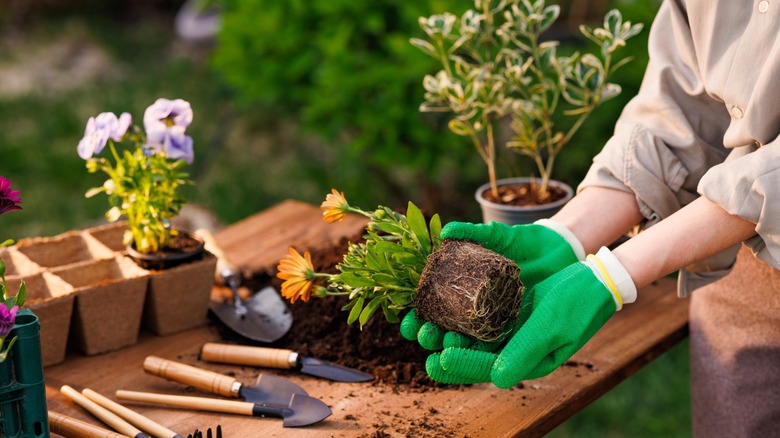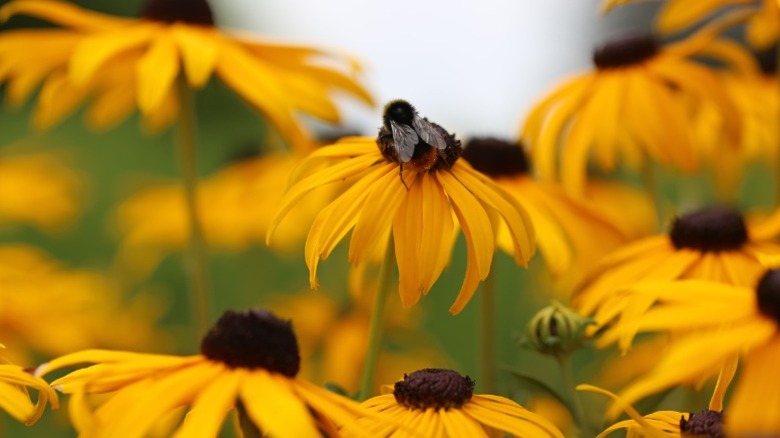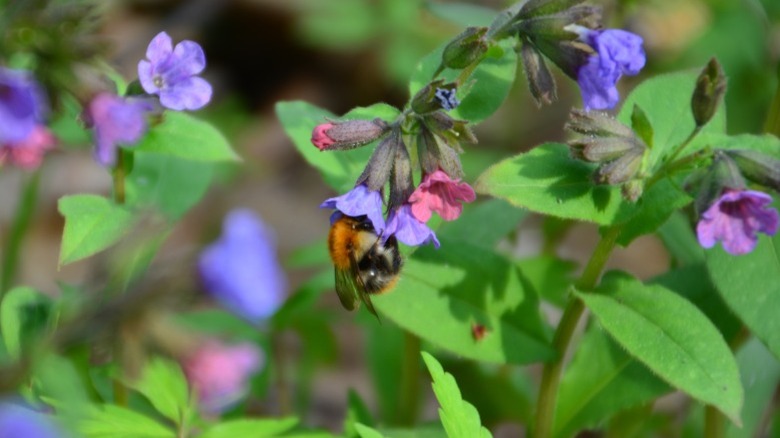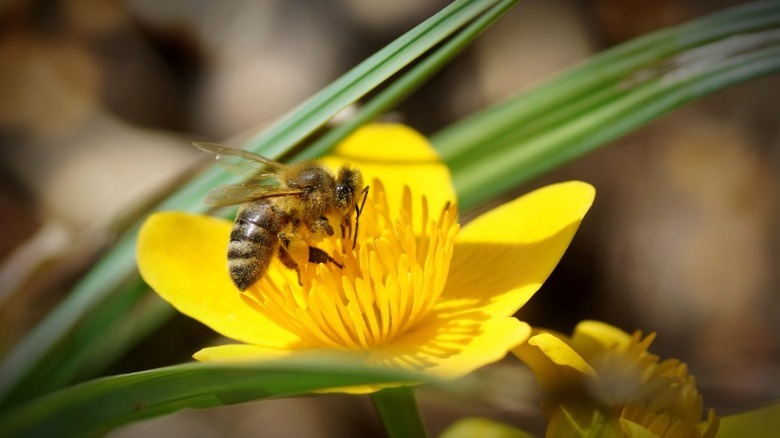Gorgeous Spring Flowers To Bring Beneficial Bees To Your Yard
If you're a gardener, you probably understand the important relationship bees have with plants, from flowers to fruit trees to vegetables. There are many types of beneficial bees you'll want in your garden, and it's important to focus on the types of flowers that appeal to them. Unlike hummingbirds and butterflies, bees prefer daisy-like flowers that have a shallow structure, because they cannot reach into bell-shaped or trumpet-shaped flowers to get to the nectar. That's why growing black-eyed Susans (Rudbeckia hirta), lungwort (Pulmonaria officinalis), and marsh marigolds (Caltha palustris) with more open flower shapes is ideal to attract hard-working bees to your outdoor space.
Helping bees by providing them with plenty of nectar-rich flowers is a great way to support pollinators and make your own garden thrive. There is an abundance of flowers that bloom in summertime, giving bees plenty of options for food. However, springtime can be a bit more uncertain for bees looking for nectar. Growing spring-blooming flowers in your yard can ensure bees have enough to sustain them prior to summer.
Plant nectar-filled black-eyed Susan
Attract pollinators easily with the nectar-rich black-eyed Susan, a native flower common in the eastern U.S. Black-eyed Susans are members of the daisy family and are sometimes known as gloriosa daisies. If you are looking to bring bees to your yard, this bold yellow flower will do the trick thanks to the dark eye of the flower head. The beauty of the black-eyed Susan is how easy it is for smaller pollinators to access the nectar. Pollinators are able to retrieve nectar from the hundreds of individual flowers in this shallow eye. Black-eyed Susans can grow between 1 and 3 feet tall and typically reseed every year.
Black-eyed Susans are a robust type of wildflower that is easy to grow in a garden. Plant them in full sun with moist, well-drained soil for the best blooms. Hardy in zones 3 through 8, they make a neat addition to a border spot or featured in a native garden. They are dependable almost anywhere in your yard, with natural deer resistance thanks to coarse foliage and a rapid growth rate that gives you blooms in the first growing season. This cheerful plant also extends its utility outside of spring, providing tasty seeds towards the end of the summer. These seeds make it a colorful perennial that'll keep birds flocking to your yard all winter long.
Grow color-changing lungwort
In the spring, lungwort produces pink blooms which are attractive to bees and other pollinators. This unique flower eventually turns a rose-violet color and finally blue, with one plant showcasing a range of colors at once. Its leaves are also beautiful, typically spotted with white or silver. Although this flower is a native to Europe, it is not invasive due to a slow growth rate. Named in the 16th and 17th centuries in reference to its perceived ability to treat lung diseases, lungwort is much better used to attract bees to your yard. Lungwort grows in clumps that can spread 2 to 3 feet wide.
Lungwort is an ideal flower to bring bees to your shady garden beds as you can grow it in either partial or deep shade without compromising on the colorful blooms. Although this flower is fairly picky and needs soil to be just right, not too wet and not too dry, it otherwise has very few maintenance requirements after its establishment. You don't need to worry about pest issues with lungwort or adding heavy fertilizer. Grow lungwort in a shaded part of the garden to attract bees and perhaps have it double as attractive ground cover.
Sow low-maintenance marsh marigold
Plant marsh marigold in a moist area of your garden for an easy flower reminiscent of buttercups. Despite its name, this plant is not related to marigolds at all and is native to North America. Marsh marigold, also known as cowslip, provides early spring blooms that can benefit bees and other pollinators. The small flowers are golden yellow and have waxy petals, which don't really look anything like true marigolds. These flowers bloom between mid-April and June, and while they appear all yellow to our naked eye, a part of the petals attract insects with an ultraviolet color known as "bee's purple."
Ideally, marsh marigolds require damp soil and almost constant moisture to thrive. To ensure they get enough water, plant them at the edges of ponds, in low-lying areas of your lawn, or in a rain garden. These flowering plants that thrive in soggy soil will even tolerate occasional flooding. They grow well in full sun to light shade, but prefer full sun. In areas with hot summers, planting marsh marigolds in full sun can make the plant go dormant. It has a creeping growth habit that means it spreads easily, but not aggressively, in your garden. Marsh marigolds are hardy from zones 3 to 7, although they are locally native to mountainous areas.



